How to build a spacecraft without leaving the office
The DX1 satellite, born to become the first private spacecraft in Russia, was late for this title, but for the company-developer it will forever remain the firstborn. About a year he was created, more than six months waiting for the launch, and finally took his place in the Soyuz 2.1b rocket.

What you need to create your spacecraft? What difficulties will have to be solved? How much does it all cost? Answers to these questions had to be found before the satellite was sent to Baikonur.
Many of Dauria Aerospace already had experience in creating spacecraft and were ready to work, but in order to form a well-coordinated team it was required to go through all the stages of creating a spacecraft. Only having accumulated a joint positive and negative experience, having gone through the whole process from concept to launch and operation, it is safe to talk about the company's readiness for further accomplishments. This was probably the main motive for creating the DX1. But more prosaic factors played an important role: it was necessary to write and test the software of the device, ready for use on other satellites of the company; build chains of suppliers and subcontractors; prepare the assembly site.
')
As a rule, satellites are created for specific tasks or orders. The company did not yet have such companies, so they decided to develop a universal platform based on the possibility of launching with the Roskosmos satellite Meteor-M No. 2. Immediately laid the possibility of this platform to implement both the company's projects and to order. When choosing a platform concept, we proceeded from a number of parameters:
1) weight up to 100 kg, - so-called class "microsatellites";
2) scalability - the possibility of changing the dimensions of the platform, without changing the basic elements and avionics, and, as a result - the general software;
3) a wide range of applications - equipping the platform with means of high-precision orientation, which allows satellites, for example, to survey the earth's surface or perform astrophysical tasks.
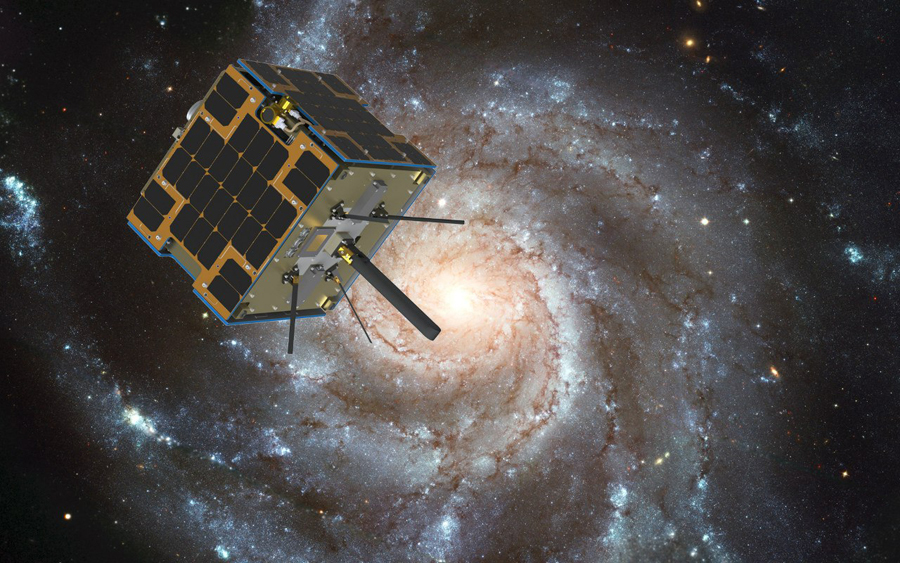
The result was the DX1 project - “Dauria Experimental First.” In order not to launch a simple technological demonstrator, the satellite was equipped with an AIS signal receiving unit - this is how it received commercial application and the possibility of partial or full payback. But this device must confirm the ability to exceed the needs of this payload.
The power consumption of the AIS unit is not high, which made it possible to dispense with a drop-down solar panels. This simplified the design, facilitated the work and management. But even so, the satellite is capable of producing energy three times more than it really needs.
The airborne radio complex operates in two ranges: VHF and S. Obtaining permission to use them over the territory of Russia took almost as much as creating the device itself.
The main technical characteristics of the DX1 are visible from the table:
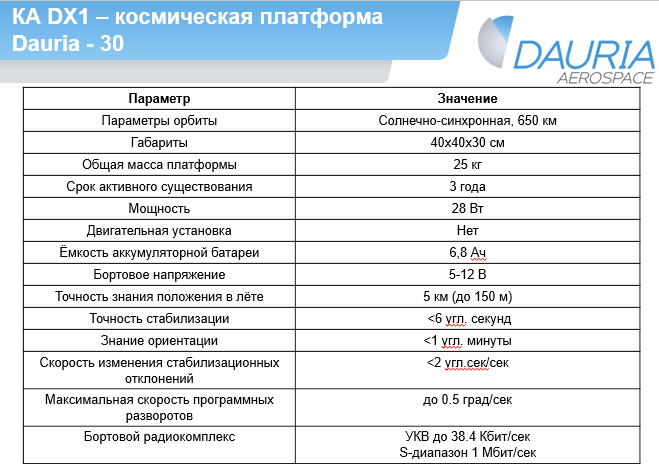
Positioning in orbit up to hundreds of meters and pointing accuracy up to 6 arcseconds are characteristics suitable for shooting the surface of the Earth or planetary astronomy. Such opportunities laid in store, with the expectation of future tasks.
The birth of the device began with an assessment of what modern world industry can offer. Traveled a bunch of exhibitions and forums around the world. Looking for components of the industrial class, i.e. suitable for use in industry on Earth. Space or military components are more expensive by orders of magnitude, which is contrary to the ideology of the intended business. And with the advent of sanctions, difficulties would only increase.
But now industrial electronics is capable of performing space tasks. Actually, Roskosmos state companies do not stop using it. At Phobos-Grunt, this did not work, but in near-earth space, satellites on “non-cosmic” components work up to ten years. Roscosmos uses such electronics because there is simply no other: its microelectronics are often not ready to offer what is necessary, and foreigners simply do not sell “space” and “military” .
“Dauria” deliberately goes to “industrialization” considering additional ways of protection in space: shielding with a thick layer of aluminum, duplication, hardware and software.
As a result, the onboard machine DX1 became similar to the part from the tank, but in general the satellite turned out to be quite light, for its dimensions - 22 kg. (Joke about positive buoyancy). Onboard computer stuffing already has flight practice on a NASA experimental satellite.
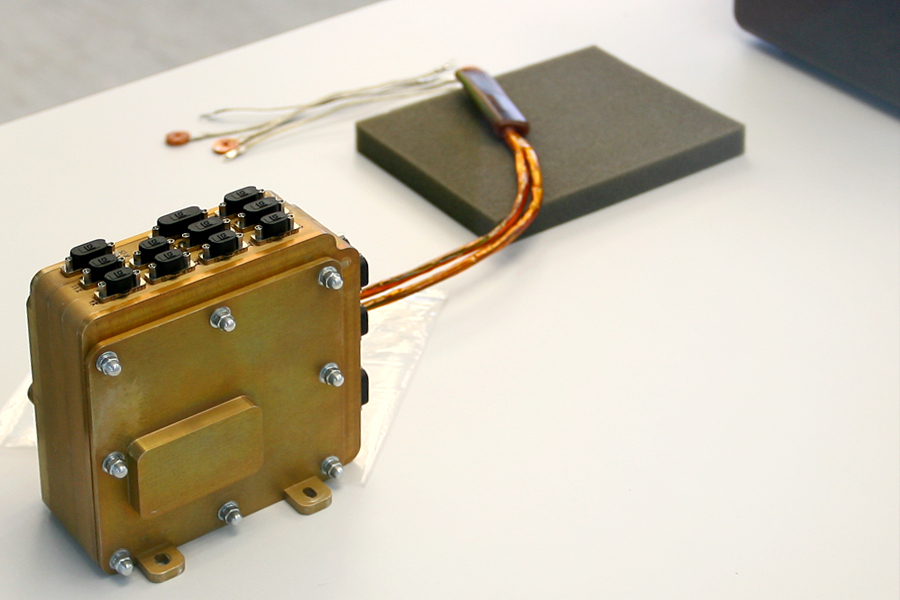
The architecture of the satellite is built on a supporting aluminum frame, and solar panels act as walls. The devices are mounted on the top and bottom panels and vertical racks. The frame was milled according to its own drawings. They thought about 3D printing, but for now there are concerns that metal printing will not give the required accuracy, and it will be more expensive than the milling cutter, so we wait until the technology develops to the desired quality.
The unpleasant news was the fact that often the supplied components do not correspond to the declared characteristics. Therefore, we checked everything before installation on the device. Sometimes I had to be smart. For example, the orientation system gyroscopes were tested on an astronomical mount. It was lucky that one of the engineers, in his spare time from the conquest of the near space, is engaged in contemplation of the distant.
In the photo - the solar sensor is tested under the rays of an artificial "sun":
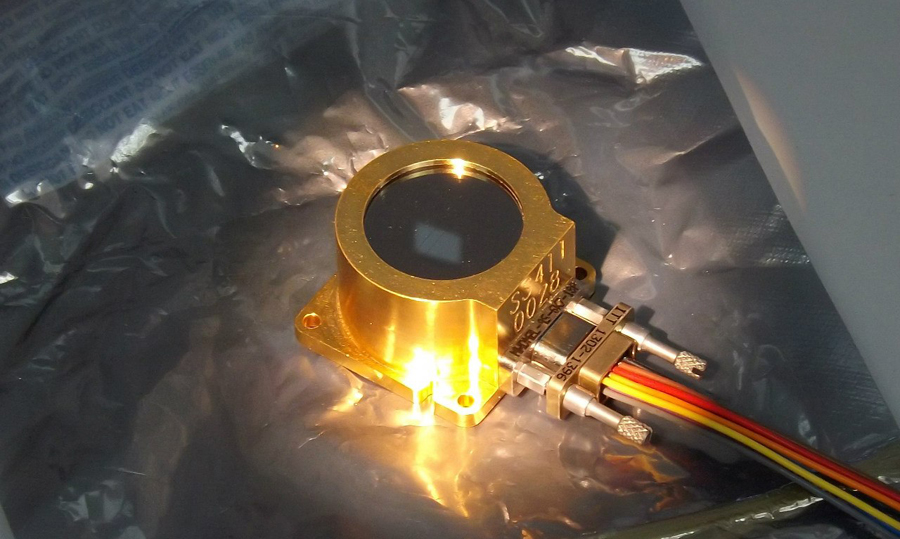
Another device for which I have high hopes is the star sensor. Russian, by the way, production. It can be seen on the opposite face of the antenna apparatus. It should be used for star orientation and satellite positioning. In fact, this is a low resolution black and white camera, but this is the only camera on the satellite, so I hope to persuade our specialists to shoot the moon in the new moon. Similar shooting and transfer of a picture is theoretically possible, but it is necessary to try. This will be the best proof of the efficiency of the device.
Although the company did not report to anyone for the development of the DX1, but the engineers decided to carry out a full range of tests that Roscosmos spacecraft must withstand. For this purpose, we created an overall mass layout for vibrodynamic tests. He had to confirm the reliability of the satellite design, its readiness to withstand the overload during the launch of the launch vehicle. After successfully passing the tests, the model became the first exhibit of the future museum of private cosmonautics in Russia. He managed to light up in several TV scenes and photo reports (this is a remark for the most attentive, who could be surprised by the twisted pair on the spacecraft).

Another model - the antenna - was checked in an anechoic chamber, which allows us to estimate the propagation of radio waves in conditions close to the cosmic one. They also confirmed the characteristics laid by the designers.
Finally, the already fully assembled spacecraft was checked in a thermal vacuum chamber. This stage of testing allowed to assess the readiness of the apparatus to work in conditions of cosmic cold and heat. Here a flaw was revealed: it turned out that, while stationary, the satellite overheats strongly on the sunny side. In principle, this is not fatal - it is enough to launch the device in the “kebab” mode, i.e. regularly rotate, exposing the different facets of the sun. But such a regime would not allow performing a series of operations for future prospective missions. Therefore, the problem was solved by a constructive method - we replaced the solar cell brackets from aluminum to copper. The thermal conductivity of copper is higher, so excess heat must “leak” onto the case and dissipate on the shadow side.
In general, the maintenance of a thermal regime on spacecraft is an entire art, somehow I will tell about it separately. All the elements of the satellite, except for antennas and solar batteries, were wrapped in screen-vacuum thermal insulation - “golden foil” before the tests. Unlike electronics, there was a high-quality domestic manufacturer - KAM Research Institute from Pereslavl. First, our specialist in thermal conditions has mastered the skills of cutting and sewing and drew a natural pattern. They made a draft of thermal insulation for it and came to our office for a natural fitting.
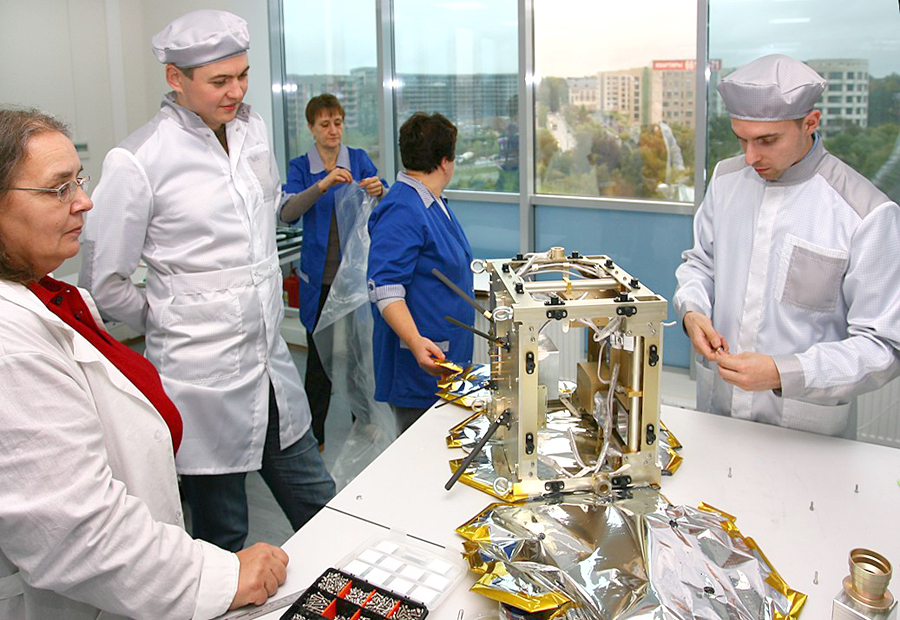
The suit sat down not immediately, but as a result our cavalier went to Baikonur during the parade.
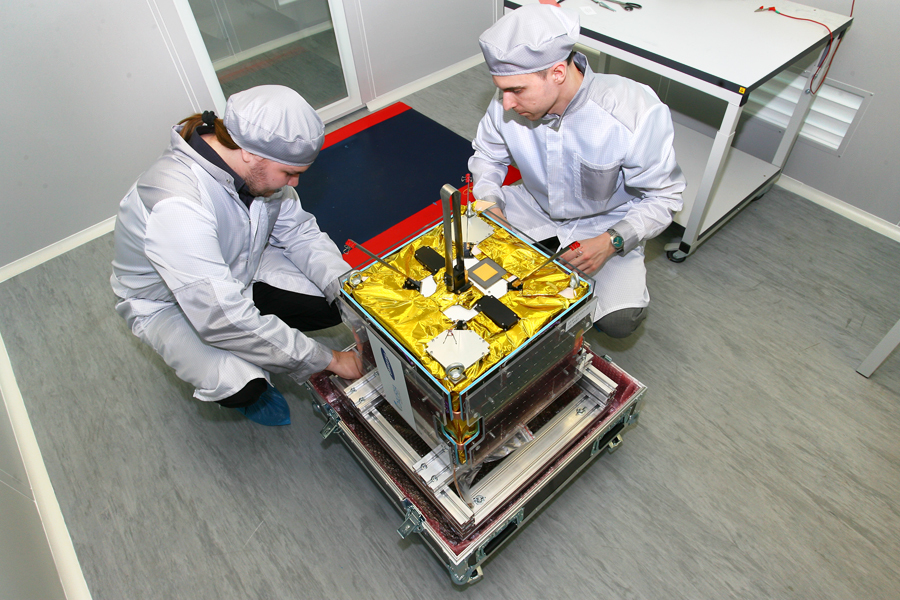
Before the launch itself, we were almost spoiled by the start - we screwed the satellite so qualitatively to the upper stage that we passed the cable through which the team had to go to the station. As a result, the exposed wire is short-circuited to the case and discharges the battery ...
It takes less than three weeks to start, more than 2 thousand km to Baikonur, spare parts in Moscow. Roscosmos postponed the launch for more than a year, so no one would wait for us. The bill went to the clock: have time to fix it or not? The first flight to Baikonur on Saturday went to our children with the help of a spare cable. Another brought a massive model of the device - a metal blank, which would replace the satellite, if it was removed. The rocket flight program was written in advance, so any discrepancy by mass could have ruined the entire launch.
Replace something other than the cable did not have time physically. The satellite was removed from the upper stage, the cable was replaced, and the battery was charged - it took two days. Then I had to check the operation of the devices - to make sure that the short circuit did not burn out any kind of microcircuit. Deviations from the norm did not reveal and decided to fly.
Photos from the workshops of Baikonur can not be shown, so here is the Baykonur gopher :)

How to fly, and how it will work DX1 will soon find out. The experts of Dauria are confident in their work. Rocket "Union" reliable. The “Frigate” overclocking unit also works like a clock. Now the main thing is not to let down the components, and we will have space.
PS I think the text will cause many questions. I will immediately warn you that I cannot answer all the narrow technical questions. I will ask the engineers to help, but they have now, on the eve of the launch, something to do, and the concept of a trade secret has not been canceled. Therefore, if whose questions remain unanswered - understand and forgive.

What you need to create your spacecraft? What difficulties will have to be solved? How much does it all cost? Answers to these questions had to be found before the satellite was sent to Baikonur.
Many of Dauria Aerospace already had experience in creating spacecraft and were ready to work, but in order to form a well-coordinated team it was required to go through all the stages of creating a spacecraft. Only having accumulated a joint positive and negative experience, having gone through the whole process from concept to launch and operation, it is safe to talk about the company's readiness for further accomplishments. This was probably the main motive for creating the DX1. But more prosaic factors played an important role: it was necessary to write and test the software of the device, ready for use on other satellites of the company; build chains of suppliers and subcontractors; prepare the assembly site.
')
As a rule, satellites are created for specific tasks or orders. The company did not yet have such companies, so they decided to develop a universal platform based on the possibility of launching with the Roskosmos satellite Meteor-M No. 2. Immediately laid the possibility of this platform to implement both the company's projects and to order. When choosing a platform concept, we proceeded from a number of parameters:
1) weight up to 100 kg, - so-called class "microsatellites";
2) scalability - the possibility of changing the dimensions of the platform, without changing the basic elements and avionics, and, as a result - the general software;
3) a wide range of applications - equipping the platform with means of high-precision orientation, which allows satellites, for example, to survey the earth's surface or perform astrophysical tasks.

The result was the DX1 project - “Dauria Experimental First.” In order not to launch a simple technological demonstrator, the satellite was equipped with an AIS signal receiving unit - this is how it received commercial application and the possibility of partial or full payback. But this device must confirm the ability to exceed the needs of this payload.
The power consumption of the AIS unit is not high, which made it possible to dispense with a drop-down solar panels. This simplified the design, facilitated the work and management. But even so, the satellite is capable of producing energy three times more than it really needs.
The airborne radio complex operates in two ranges: VHF and S. Obtaining permission to use them over the territory of Russia took almost as much as creating the device itself.
The main technical characteristics of the DX1 are visible from the table:

Positioning in orbit up to hundreds of meters and pointing accuracy up to 6 arcseconds are characteristics suitable for shooting the surface of the Earth or planetary astronomy. Such opportunities laid in store, with the expectation of future tasks.
The birth of the device began with an assessment of what modern world industry can offer. Traveled a bunch of exhibitions and forums around the world. Looking for components of the industrial class, i.e. suitable for use in industry on Earth. Space or military components are more expensive by orders of magnitude, which is contrary to the ideology of the intended business. And with the advent of sanctions, difficulties would only increase.
But now industrial electronics is capable of performing space tasks. Actually, Roskosmos state companies do not stop using it. At Phobos-Grunt, this did not work, but in near-earth space, satellites on “non-cosmic” components work up to ten years. Roscosmos uses such electronics because there is simply no other: its microelectronics are often not ready to offer what is necessary, and foreigners simply do not sell “space” and “military” .
“Dauria” deliberately goes to “industrialization” considering additional ways of protection in space: shielding with a thick layer of aluminum, duplication, hardware and software.
As a result, the onboard machine DX1 became similar to the part from the tank, but in general the satellite turned out to be quite light, for its dimensions - 22 kg. (Joke about positive buoyancy). Onboard computer stuffing already has flight practice on a NASA experimental satellite.

The architecture of the satellite is built on a supporting aluminum frame, and solar panels act as walls. The devices are mounted on the top and bottom panels and vertical racks. The frame was milled according to its own drawings. They thought about 3D printing, but for now there are concerns that metal printing will not give the required accuracy, and it will be more expensive than the milling cutter, so we wait until the technology develops to the desired quality.
The unpleasant news was the fact that often the supplied components do not correspond to the declared characteristics. Therefore, we checked everything before installation on the device. Sometimes I had to be smart. For example, the orientation system gyroscopes were tested on an astronomical mount. It was lucky that one of the engineers, in his spare time from the conquest of the near space, is engaged in contemplation of the distant.
In the photo - the solar sensor is tested under the rays of an artificial "sun":

Another device for which I have high hopes is the star sensor. Russian, by the way, production. It can be seen on the opposite face of the antenna apparatus. It should be used for star orientation and satellite positioning. In fact, this is a low resolution black and white camera, but this is the only camera on the satellite, so I hope to persuade our specialists to shoot the moon in the new moon. Similar shooting and transfer of a picture is theoretically possible, but it is necessary to try. This will be the best proof of the efficiency of the device.
Although the company did not report to anyone for the development of the DX1, but the engineers decided to carry out a full range of tests that Roscosmos spacecraft must withstand. For this purpose, we created an overall mass layout for vibrodynamic tests. He had to confirm the reliability of the satellite design, its readiness to withstand the overload during the launch of the launch vehicle. After successfully passing the tests, the model became the first exhibit of the future museum of private cosmonautics in Russia. He managed to light up in several TV scenes and photo reports (this is a remark for the most attentive, who could be surprised by the twisted pair on the spacecraft).

Another model - the antenna - was checked in an anechoic chamber, which allows us to estimate the propagation of radio waves in conditions close to the cosmic one. They also confirmed the characteristics laid by the designers.
Finally, the already fully assembled spacecraft was checked in a thermal vacuum chamber. This stage of testing allowed to assess the readiness of the apparatus to work in conditions of cosmic cold and heat. Here a flaw was revealed: it turned out that, while stationary, the satellite overheats strongly on the sunny side. In principle, this is not fatal - it is enough to launch the device in the “kebab” mode, i.e. regularly rotate, exposing the different facets of the sun. But such a regime would not allow performing a series of operations for future prospective missions. Therefore, the problem was solved by a constructive method - we replaced the solar cell brackets from aluminum to copper. The thermal conductivity of copper is higher, so excess heat must “leak” onto the case and dissipate on the shadow side.
In general, the maintenance of a thermal regime on spacecraft is an entire art, somehow I will tell about it separately. All the elements of the satellite, except for antennas and solar batteries, were wrapped in screen-vacuum thermal insulation - “golden foil” before the tests. Unlike electronics, there was a high-quality domestic manufacturer - KAM Research Institute from Pereslavl. First, our specialist in thermal conditions has mastered the skills of cutting and sewing and drew a natural pattern. They made a draft of thermal insulation for it and came to our office for a natural fitting.

The suit sat down not immediately, but as a result our cavalier went to Baikonur during the parade.

Before the launch itself, we were almost spoiled by the start - we screwed the satellite so qualitatively to the upper stage that we passed the cable through which the team had to go to the station. As a result, the exposed wire is short-circuited to the case and discharges the battery ...
It takes less than three weeks to start, more than 2 thousand km to Baikonur, spare parts in Moscow. Roscosmos postponed the launch for more than a year, so no one would wait for us. The bill went to the clock: have time to fix it or not? The first flight to Baikonur on Saturday went to our children with the help of a spare cable. Another brought a massive model of the device - a metal blank, which would replace the satellite, if it was removed. The rocket flight program was written in advance, so any discrepancy by mass could have ruined the entire launch.
Replace something other than the cable did not have time physically. The satellite was removed from the upper stage, the cable was replaced, and the battery was charged - it took two days. Then I had to check the operation of the devices - to make sure that the short circuit did not burn out any kind of microcircuit. Deviations from the norm did not reveal and decided to fly.
Photos from the workshops of Baikonur can not be shown, so here is the Baykonur gopher :)

How to fly, and how it will work DX1 will soon find out. The experts of Dauria are confident in their work. Rocket "Union" reliable. The “Frigate” overclocking unit also works like a clock. Now the main thing is not to let down the components, and we will have space.
As a bonus, the direct speech of the DX1 project manager, Alexander Malinin:
Starting the design of the DX1, we certainly did not know what this might lead to. Of course, before this, each person in the team was engaged in one or another task of developing the spacecraft, but to make the spacecraft from the first sketch to the last bolt, none of the engineers did.
Design began on the system used in the United States for most spacecraft. Passed the stages of PDR and CDR, the device at first glance was rendered. At this stage, an important mistake was made, one of the systems, in particular, ASF, was poorly developed, which adversely affected the subsequent design and production stages. Then I had to adjust this system to the existing dimensions and limitations, which were too late to change.
The general view of the spacecraft design was chosen at an early design stage, so we didn’t have large throwings in this regard. But the process of production of this very structure was delayed for months. After all, in order to make a small part of aluminum, it had to be drawn in detail in the drawings, to introduce restrictions on the tolerances and roughness. These are the realities of the domestic metalworking companies, units are ready to work on the 3D model, and their quality leaves much to be desired.
But now, the design of the spacecraft was completed, and the first copies of the flight and technological samples of the instruments began to arrive at the office. The stage of autonomous, and after and complex testing of spacecraft instruments and systems has begun. With some devices, there were fewer difficulties, with some much more. It turned out that not all devices work as stated in the documentation for it. We had to solve these problems along the way and refine the part that depended on us, be it cables or interface settings.
With the flight cables for the spacecraft came a separate story. Everything, at least once, had worked with them before and it was taken for granted. But now, we ourselves had to develop them. This was a completely new task for us, which no one had previously encountered. But, we were able to cope with it and build up the required competencies, albeit at the cost of several months. We have fully purchased the necessary components: wires, screens, adhesives, potting, connectors, covers, etc. And independently made and tested them.
Having passed the difficult stage of testing as part of a complex stand, our designers began to assemble the spacecraft. Due to the fact that those who designed the spacecraft, the same people and collected it, the process went cheerfully. There was no need to issue extra documentation between the services, because these services were on the face of the same people.
Having collected the spacecraft, we proceeded to the complex testing of spacecraft, and then to the TTI. And at this stage I clearly realized: to test and debug the spacecraft nodes separately and do the same thing over the spacecraft assembly, these are completely different things. At first, nothing works, both on software and hardware levels. But work is underway, and now the spacecraft began to function as we wanted. Not quickly, gradually, day by day. But started!
To say that the enthusiasm to create your own spacecraft was great is to say nothing. We worked 12-14 hours a day, sometimes seven days a week. There were days when everything goes wrong, and deadlines are tight. These days, hands are falling and faith in one's own strength and success is waning. But tomorrow, the new day will come, and you will again systematically bring your brainchild back to the logical final.
Now, having finished all the stages of the development of a spacecraft, I can say that we have become much more experienced, confident and, most importantly, much more professional ambitious people.
Now we have the most important thing to do, to launch the spacecraft and receive the first signal from it. It would seem such a trifle in comparison with what we have already done. But this trifle will be so long-awaited and earned by labor, that for the sake of this it is worth doing this work!
Design began on the system used in the United States for most spacecraft. Passed the stages of PDR and CDR, the device at first glance was rendered. At this stage, an important mistake was made, one of the systems, in particular, ASF, was poorly developed, which adversely affected the subsequent design and production stages. Then I had to adjust this system to the existing dimensions and limitations, which were too late to change.
The general view of the spacecraft design was chosen at an early design stage, so we didn’t have large throwings in this regard. But the process of production of this very structure was delayed for months. After all, in order to make a small part of aluminum, it had to be drawn in detail in the drawings, to introduce restrictions on the tolerances and roughness. These are the realities of the domestic metalworking companies, units are ready to work on the 3D model, and their quality leaves much to be desired.
But now, the design of the spacecraft was completed, and the first copies of the flight and technological samples of the instruments began to arrive at the office. The stage of autonomous, and after and complex testing of spacecraft instruments and systems has begun. With some devices, there were fewer difficulties, with some much more. It turned out that not all devices work as stated in the documentation for it. We had to solve these problems along the way and refine the part that depended on us, be it cables or interface settings.
With the flight cables for the spacecraft came a separate story. Everything, at least once, had worked with them before and it was taken for granted. But now, we ourselves had to develop them. This was a completely new task for us, which no one had previously encountered. But, we were able to cope with it and build up the required competencies, albeit at the cost of several months. We have fully purchased the necessary components: wires, screens, adhesives, potting, connectors, covers, etc. And independently made and tested them.
Having passed the difficult stage of testing as part of a complex stand, our designers began to assemble the spacecraft. Due to the fact that those who designed the spacecraft, the same people and collected it, the process went cheerfully. There was no need to issue extra documentation between the services, because these services were on the face of the same people.
Having collected the spacecraft, we proceeded to the complex testing of spacecraft, and then to the TTI. And at this stage I clearly realized: to test and debug the spacecraft nodes separately and do the same thing over the spacecraft assembly, these are completely different things. At first, nothing works, both on software and hardware levels. But work is underway, and now the spacecraft began to function as we wanted. Not quickly, gradually, day by day. But started!
To say that the enthusiasm to create your own spacecraft was great is to say nothing. We worked 12-14 hours a day, sometimes seven days a week. There were days when everything goes wrong, and deadlines are tight. These days, hands are falling and faith in one's own strength and success is waning. But tomorrow, the new day will come, and you will again systematically bring your brainchild back to the logical final.
Now, having finished all the stages of the development of a spacecraft, I can say that we have become much more experienced, confident and, most importantly, much more professional ambitious people.
Now we have the most important thing to do, to launch the spacecraft and receive the first signal from it. It would seem such a trifle in comparison with what we have already done. But this trifle will be so long-awaited and earned by labor, that for the sake of this it is worth doing this work!
PS I think the text will cause many questions. I will immediately warn you that I cannot answer all the narrow technical questions. I will ask the engineers to help, but they have now, on the eve of the launch, something to do, and the concept of a trade secret has not been canceled. Therefore, if whose questions remain unanswered - understand and forgive.
Source: https://habr.com/ru/post/228431/
All Articles